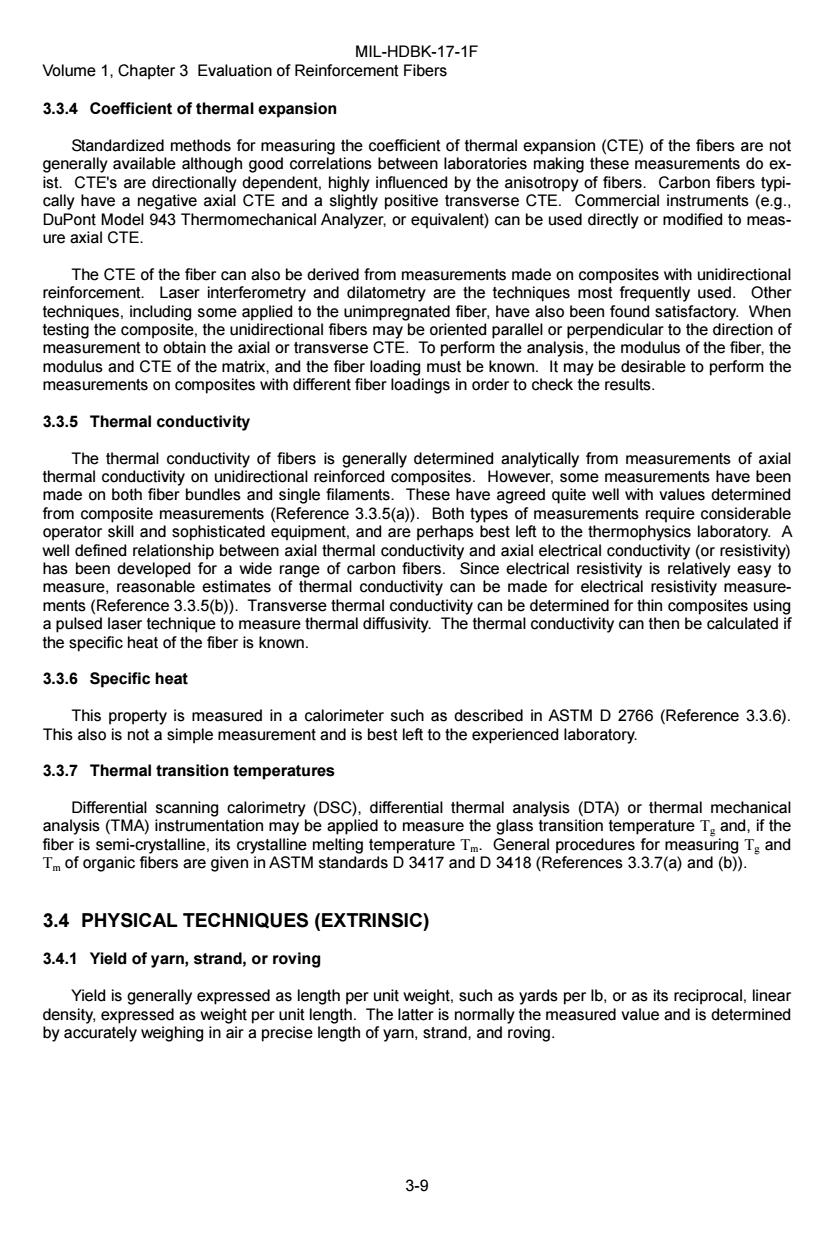正在加载图片...

MIL-HDBK-17-1F Volume 1,Chapter 3 Evaluation of Reinforcement Fibers 3.3.4 Coefficient of thermal expansion Standardized methods for measuring the coefficient of thermal expansion(CTE)of the fibers are not generally available although good correlations between laboratories making these measurements do ex- ist.CTE's are directionally dependent,highly influenced by the anisotropy of fibers.Carbon fibers typi- cally have a negative axial CTE and a slightly positive transverse CTE.Commercial instruments (e.g., DuPont Model 943 Thermomechanical Analyzer,or equivalent)can be used directly or modified to meas- ure axial CTE. The CTE of the fiber can also be derived from measurements made on composites with unidirectional reinforcement.Laser interferometry and dilatometry are the techniques most frequently used.Other techniques,including some applied to the unimpregnated fiber,have also been found satisfactory.When testing the composite,the unidirectional fibers may be oriented parallel or perpendicular to the direction of measurement to obtain the axial or transverse CTE.To perform the analysis,the modulus of the fiber,the modulus and CTE of the matrix,and the fiber loading must be known.It may be desirable to perform the measurements on composites with different fiber loadings in order to check the results. 3.3.5 Thermal conductivity The thermal conductivity of fibers is generally determined analytically from measurements of axial thermal conductivity on unidirectional reinforced composites.However,some measurements have been made on both fiber bundles and single filaments.These have agreed quite well with values determined from composite measurements (Reference 3.3.5(a)).Both types of measurements require considerable operator skill and sophisticated equipment,and are perhaps best left to the thermophysics laboratory.A well defined relationship between axial thermal conductivity and axial electrical conductivity (or resistivity) has been developed for a wide range of carbon fibers.Since electrical resistivity is relatively easy to measure,reasonable estimates of thermal conductivity can be made for electrical resistivity measure- ments(Reference 3.3.5(b)).Transverse thermal conductivity can be determined for thin composites using a pulsed laser technique to measure thermal diffusivity.The thermal conductivity can then be calculated if the specific heat of the fiber is known. 3.3.6 Specific heat This property is measured in a calorimeter such as described in ASTM D 2766(Reference 3.3.6). This also is not a simple measurement and is best left to the experienced laboratory. 3.3.7 Thermal transition temperatures Differential scanning calorimetry (DSC),differential thermal analysis (DTA)or thermal mechanical analysis(TMA)instrumentation may be applied to measure the glass transition temperature T.and,if the fiber is semi-crystalline,its crystalline melting temperature Tm.General procedures for measuring T:and Tm of organic fibers are given in ASTM standards D 3417 and D 3418(References 3.3.7(a)and(b)). 3.4 PHYSICAL TECHNIQUES(EXTRINSIC) 3.4.1 Yield of yarn,strand,or roving Yield is generally expressed as length per unit weight,such as yards per Ib,or as its reciprocal,linear density,expressed as weight per unit length.The latter is normally the measured value and is determined by accurately weighing in air a precise length of yarn,strand,and roving. 3-9MIL-HDBK-17-1F Volume 1, Chapter 3 Evaluation of Reinforcement Fibers 3-9 3.3.4 Coefficient of thermal expansion Standardized methods for measuring the coefficient of thermal expansion (CTE) of the fibers are not generally available although good correlations between laboratories making these measurements do exist. CTE's are directionally dependent, highly influenced by the anisotropy of fibers. Carbon fibers typically have a negative axial CTE and a slightly positive transverse CTE. Commercial instruments (e.g., DuPont Model 943 Thermomechanical Analyzer, or equivalent) can be used directly or modified to measure axial CTE. The CTE of the fiber can also be derived from measurements made on composites with unidirectional reinforcement. Laser interferometry and dilatometry are the techniques most frequently used. Other techniques, including some applied to the unimpregnated fiber, have also been found satisfactory. When testing the composite, the unidirectional fibers may be oriented parallel or perpendicular to the direction of measurement to obtain the axial or transverse CTE. To perform the analysis, the modulus of the fiber, the modulus and CTE of the matrix, and the fiber loading must be known. It may be desirable to perform the measurements on composites with different fiber loadings in order to check the results. 3.3.5 Thermal conductivity The thermal conductivity of fibers is generally determined analytically from measurements of axial thermal conductivity on unidirectional reinforced composites. However, some measurements have been made on both fiber bundles and single filaments. These have agreed quite well with values determined from composite measurements (Reference 3.3.5(a)). Both types of measurements require considerable operator skill and sophisticated equipment, and are perhaps best left to the thermophysics laboratory. A well defined relationship between axial thermal conductivity and axial electrical conductivity (or resistivity) has been developed for a wide range of carbon fibers. Since electrical resistivity is relatively easy to measure, reasonable estimates of thermal conductivity can be made for electrical resistivity measurements (Reference 3.3.5(b)). Transverse thermal conductivity can be determined for thin composites using a pulsed laser technique to measure thermal diffusivity. The thermal conductivity can then be calculated if the specific heat of the fiber is known. 3.3.6 Specific heat This property is measured in a calorimeter such as described in ASTM D 2766 (Reference 3.3.6). This also is not a simple measurement and is best left to the experienced laboratory. 3.3.7 Thermal transition temperatures Differential scanning calorimetry (DSC), differential thermal analysis (DTA) or thermal mechanical analysis (TMA) instrumentation may be applied to measure the glass transition temperature Tg and, if the fiber is semi-crystalline, its crystalline melting temperature Tm. General procedures for measuring Tg and Tm of organic fibers are given in ASTM standards D 3417 and D 3418 (References 3.3.7(a) and (b)). 3.4 PHYSICAL TECHNIQUES (EXTRINSIC) 3.4.1 Yield of yarn, strand, or roving Yield is generally expressed as length per unit weight, such as yards per lb, or as its reciprocal, linear density, expressed as weight per unit length. The latter is normally the measured value and is determined by accurately weighing in air a precise length of yarn, strand, and roving